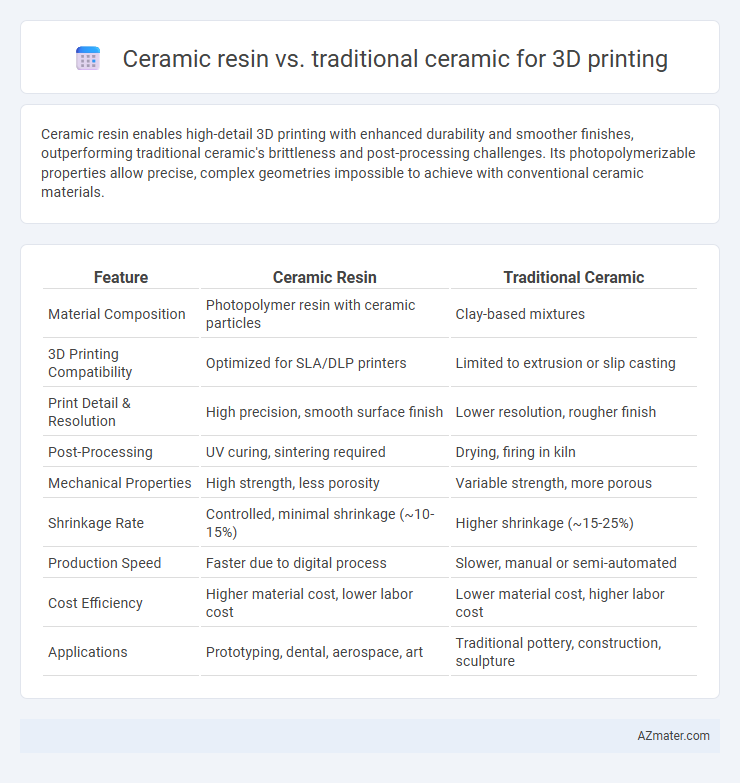Ceramic resin enables high-detail 3D printing with enhanced durability and smoother finishes, outperforming traditional ceramic's brittleness and post-processing challenges. Its photopolymerizable properties allow precise, complex geometries impossible to achieve with conventional ceramic materials.
Table of Comparison
| Feature | Ceramic Resin | Traditional Ceramic |
|---|---|---|
| Material Composition | Photopolymer resin with ceramic particles | Clay-based mixtures |
| 3D Printing Compatibility | Optimized for SLA/DLP printers | Limited to extrusion or slip casting |
| Print Detail & Resolution | High precision, smooth surface finish | Lower resolution, rougher finish |
| Post-Processing | UV curing, sintering required | Drying, firing in kiln |
| Mechanical Properties | High strength, less porosity | Variable strength, more porous |
| Shrinkage Rate | Controlled, minimal shrinkage (~10-15%) | Higher shrinkage (~15-25%) |
| Production Speed | Faster due to digital process | Slower, manual or semi-automated |
| Cost Efficiency | Higher material cost, lower labor cost | Lower material cost, higher labor cost |
| Applications | Prototyping, dental, aerospace, art | Traditional pottery, construction, sculpture |
Introduction to Ceramic Resin and Traditional Ceramic
Ceramic resin in 3D printing offers enhanced precision and faster curing times compared to traditional ceramic, which relies on molding and firing processes. Ceramic resin formulations combine photopolymerizable substances with ceramic powders, enabling intricate designs and seamless layer bonding during additive manufacturing. Traditional ceramic materials require longer processing cycles and manual shaping, limiting complexity and increasing production time.
Composition Differences: Ceramic Resin vs Traditional Ceramic
Ceramic resin for 3D printing typically consists of a photopolymer matrix embedded with ceramic particles, allowing precise layer-by-layer curing through light exposure, whereas traditional ceramic is composed of natural clay minerals and other raw materials that require shaping and high-temperature kiln firing. The resin's synthetic polymers provide flexibility during printing and improve green part strength, while traditional ceramics rely on plasticity and drying processes before sintering. These compositional differences impact processing methods, mechanical properties, and the final microstructure of 3D-printed versus conventionally made ceramic components.
Printing Processes Compared
Ceramic resin 3D printing utilizes photopolymerization, enabling high-resolution, detailed parts with complex geometries through processes like SLA or DLP, whereas traditional ceramic 3D printing often relies on extrusion or binder jetting requiring post-processing sintering. Resin-based printing generally achieves smoother surface finishes and finer feature detail, while traditional methods benefit from broader material compatibility and larger build volumes. The choice between ceramic resin and traditional ceramics impacts print speed, resolution, and mechanical properties, making resin ideal for intricate prototypes and traditional ceramics suited for functional, structural components.
Material Properties and Performance
Ceramic resin in 3D printing offers superior flexibility and faster curing times compared to traditional ceramics, enabling intricate detail and smoother finishes with reduced brittleness. Traditional ceramic materials provide higher thermal stability and mechanical strength, making them ideal for applications requiring high-temperature resistance and durability. Ceramic resin facilitates easier post-processing and design iteration, while traditional ceramics excel in structural performance and long-term wear resistance.
Surface Finish and Detail Resolution
Ceramic resin 3D printing offers superior surface finish with smoother textures compared to traditional ceramic methods, minimizing the need for extensive post-processing. The finer particle distribution in ceramic resins enables higher detail resolution, capturing intricate features that traditional ceramic printing often struggles to reproduce accurately. This precision makes ceramic resin ideal for applications requiring complex geometries and enhanced aesthetic qualities.
Post-Processing Requirements
Ceramic resin 3D printing requires less intensive post-processing, often involving simple UV curing and minimal surface finishing, leading to faster turnaround times. Traditional ceramic printing demands extensive post-processing steps such as binder removal, sintering at high temperatures, and careful handling to prevent cracking or warping. The reduced post-processing complexity of ceramic resin systems enhances efficiency and consistency compared to the labor-intensive requirements of traditional ceramic methods.
Mechanical Strength and Durability
Ceramic resin in 3D printing offers enhanced mechanical strength compared to traditional ceramic materials due to its polymer matrix, which provides better impact resistance and flexibility. Traditional ceramic parts, while highly durable under compressive loads, tend to be brittle and more prone to fracturing during mechanical stress. The combination of ceramic particles within a resin binder in ceramic resin allows for improved durability and toughness in complex printed geometries, making it suitable for functional prototypes and end-use applications requiring higher mechanical performance.
Cost Factors and Accessibility
Ceramic resin for 3D printing typically incurs higher initial costs due to specialized materials and advanced printer requirements, while traditional ceramic methods involve lower material expenses but demand extensive manual labor and kiln usage. Accessibility to ceramic resin is limited by the need for specific 3D printers and proprietary resins, contrasted with traditional ceramics, which benefit from widespread availability of raw materials and standard crafting tools. Cost factors also include post-processing time, with ceramic resin offering faster production cycles but higher consumable costs compared to the slower, labor-intensive firing and shaping in traditional ceramics.
Ideal Applications for Each Material
Ceramic resin is ideal for intricate and high-precision 3D printing applications requiring fine detail and smooth surface finishes, such as dental implants, jewelry, and biomedical devices. Traditional ceramic materials excel in producing durable, heat-resistant parts that withstand mechanical stress, making them suitable for industrial components, cookware, and automotive parts. Choosing between ceramic resin and traditional ceramics depends on the required balance of detail, strength, and thermal properties for the specific application.
Future Trends in 3D Printed Ceramics
Ceramic resin 3D printing is advancing with enhanced material formulations that improve mechanical strength, surface finish, and printing speed compared to traditional ceramic methods reliant on powder sintering. Innovations in photopolymerizable ceramic composites enable more intricate geometries and complex internal structures, supporting the growing demand for customized biomedical implants and aerospace components. Future trends point towards integrating multi-material printing and AI-driven process optimization to achieve higher precision and functional gradation in 3D printed ceramics.

Infographic: Ceramic resin vs Traditional ceramic for 3D printing
 azmater.com
azmater.com